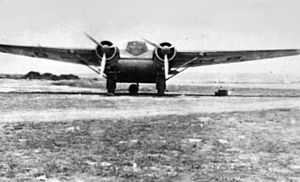Burnelli UB-14
| UB-14 | |
|---|---|
 | |
| Role | Civil transport |
| Manufacturer | Burnelli |
| Designer | Vincent Burnelli |
| First flight | 1934 |
| Number built | 3 |
| Developed into | Burnelli CBY-3 |
The Burnelli UB-14 was a 1930s American prototype lifting-fuselage airliner designed and built by Vincent Burnelli.
Design and development
Following on from his earlier designs Vincent Burnelli designed a commercial transport version using the lifting-fuselage concept. Burnelli's designs were based on the idea that an aerofoil-section fuselage would contribute to the lift generated. The Burnelli UB-14 first flew in 1934, the aerofoil-section fuselage was the centre-section of the wing. The aircraft had twin tailbooms and a widespan tailplane and elevator fitted with twin fins and rudders. The UB-14 had a retractable landing gear and was powered by two Pratt & Whitney radial engines. An enclosed cockpit for the crew of two was located on the centre wing's upper surface. The cabin held 14 to 18 passengers.
Operational history
The first prototype, UB-14, was destroyed in a 1935 accident attributed to faulty maintenance on the aileron control system.[1] Burnelli then designed and built an improved version, the UB-14B. A modified version of the UB-14B design was built under licence in the United Kingdom by Cunliffe-Owen Aircraft powered by two Bristol Perseus XIVC radials as the Cunliffe-Owen OA-1.[2] In September 1936, Burnelli applied to the CAA for aproval to fly a transatlantic flight with Clyde Edward Pangborn as the selected pilot.[3]

The Cunliffe-Owen failed its airworthiness certification due to excessive take off run and poor workmanship. It was performance tested at the A&AEE Boscombe Down in 1939.[4]
After appropriate work, in June 1941 Jim Mollison and an Air Transport Auxiliary crew delivered Cunliffe-Owen OA-1 G-AFMB to Fort Lamy, Chad. The aircraft was fitted out as a personal transport for General De Gaulle. It was later abandoned at Kabrit, and burned during VJ-Day celebrations.[5]
Variants
- UB-14 Prototype, powered by Pratt & Whitney engines. Built by Burnelli Company. Destroyed 13 January 1935, without injury to those aboard.
- UB-14B Second prototype with modifications. Built by Burnelli Company.
- UB-14B Third prototype, modified from second unit. Built by Cunliffe Owen Aircraft in United Kingdom.
Specifications (UB-14B)
General characteristics
- Crew: Two
- Capacity: 14-18 passengers
- Length: 44 ft 0 in (13.41 m)
- Wingspan: 71 ft 0 in (21.64 m)
- Height: 10 ft 0 in (3.05 m)
- Wing area: 686 ft2 (63.73 m2)
- Empty weight: 9,200 lb (4173 kg)
- Gross weight: 17,500 lb (7938 kg)
- Powerplant: 2 × Pratt & Whitney Hornet radial piston engines, 750 hp (560 kW) each each
Performance
- Maximum speed: 210 mph (383 km/h)
- Cruise speed: 205 mph (330 km/h)
- Range: 1240 miles (1996 km)
- Service ceiling: 22,000 ft (6705 m)
Airfoils:
- Fuselage: NACA 4323
- Exterior wing, root: NACA 2412
- Exterior wing, tip: NACA 2409
See also
- Related development
- Aircraft of comparable role, configuration and era
References
- Notes
- ↑ Website for Burnelli successor company
- ↑ "Fast Air Liner To Compete In Atlantic Race" Popular Mechanics, May 1937 photo shows the mockup of original UB-14B to be built by Scottish Aviation before bankruptcy. This design was going to have streamline inline engines. The OA-1 used radial engines.
- ↑ "Ocean HopPlanned In Metal Airplane". The Washington Post. 17 September 1936.
- ↑ Mason, The Secret Years Hidoki 1998 p242
- ↑ Aeroplane Monthly June 2006 p.95 with two bw plates
- ↑ Flight magazine, 1936 / pg. 1591
- Bibliography
- The Illustrated Encyclopedia of Aircraft (Part Work 1982-1985). Orbis Publishing.
External links
| Wikimedia Commons has media related to Cunliffe-Owen OA-1 . |
| ||||||
| ||||||||||||||||||||||